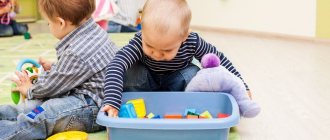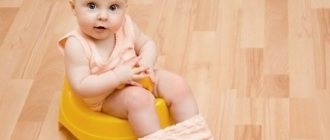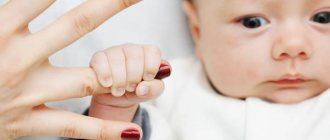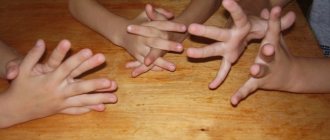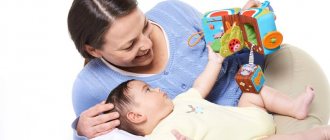Article:
Speech is the highest mental function.
It depends entirely on the level of development of the human central nervous system. It is not only a means of communication, but also the basis of thinking. A child with undeveloped speech cannot fully analyze and classify his impressions, make generalizations and conclusions about the world around him. It is not without reason that most parents and specialists: doctors, speech pathologists, speech therapists, teachers, and psychologists attach such importance to the development of speech in preschool children. The ability to clearly express one’s thoughts determines whether a child will be able to communicate freely and naturally with others. Children with developed speech actively play and communicate with peers, contact adults, and share their impressions. A child who realizes that his speech is different from the speech of his peers may begin to feel embarrassed communicating with children and adults, avoid playing together, and be afraid that they will laugh at him.
To find out whether a one-year-old baby is developing correctly, you need to know what is normal and what is pathological between the ages of birth and one year, and how you can stimulate his speech development on your own.
Stages of speech development
The development of a child’s speech from birth to one year is conventionally divided into four stages of unequal duration. The pace of development of children may not coincide in time, but this approximate periodization allows us to separate normality from pathology:
- Screaming stage. Lasts from birth to 6–8 weeks. Both the cry and the sounds made by the baby are reflex sounds. Most often these are vowel sounds with a nasal connotation. A short inhalation and an extended exhalation are accompanied by a loud cry.
- The buzzing stage. Lasts from two to five months. A child’s cry takes on an intonation coloring; it changes depending on the baby’s condition. Humming sounds and their combinations with vowels can occur both spontaneously and when communicating with an adult (agu, gee, khy, aga, ga, ege, aa). And this already becomes the beginning of the most important period - communication, communication with others. It is accompanied by the appearance of a “social” smile for everyone who communicates with the child, and a little later - the first laugh, similar to a squeal. Gushing occurs as you exhale, this is how speech breathing is trained.
- Babbling stage. The longest stage takes about 6–7 months and lasts almost until the end of the first year of life, or more precisely, until the age of 11 months. It is characterized by babbling, consisting initially of individual syllables (pa, ba, la), later turning into syllable chains (pa-pa-pa, ba-ba-ba, la-la-la), and then into the next stage - the first words that often consist of two identical syllables (pa-pa - dad, ba-ba - grandmother, la-la - doll). The oral cavity becomes more perfect, the tongue has the ability to perform a variety of movements. This makes it possible for the child to pronounce various sound complexes that sound similar to syllables with a vowel at the end: ma-ma-ma, pa-pa-pa, yes-da-da, nya-nya-nya.
- First words stage. Lasts until the end of the first year of life. These words (about 20–25) often consist of two identical syllables. This is the stage when the child begins to correlate babbling complexes with specific words. He doesn’t just pronounce a chain of syllables ma-ma-ma, but correlates the word ma-ma with a real object, reacts to the appearance of dad with the word - pa-pa. The child at this stage actively maintains contact with the adult through object-based means, manipulation with toys and objects. At the same stage, the understanding of addressed speech intensively develops, the baby actively begins to accumulate a passive vocabulary. He can't say donkey yet, but if you ask for a donkey toy, he will give it.
Development of movements in a child at 6 months
2.1. Encouraging crawling: how to teach a child to crawl?
Crawling is the most important type of movement for six-month-old babies.
With a six-month-old baby, it is very important to carry out games and exercises that encourage him to crawl. To stimulate crawling, attract the child by showing a toy, name it, call the child by name, encourage him to crawl to the toy. As soon as the baby crawls to the toy, they give him the opportunity to play with it.
You can play hide , either hiding the toy or showing it and encouraging him to crawl to it. With six-month-old children, you can already play “catch-catch,” so that the baby, laughing, crawls away from you, and you “catch up” with him. Moreover, the pace of crawling in “catch-up” should increase - you catch up faster and faster, and the baby changes the speed of crawling.
Some parents say that their child did not crawl at all, but walked, as expected, at one year. According to foreign data, this situation now occurs in 15% of modern families (D. Hopkin - Itogi magazine, 1998) Yes, this happens if the baby is simply not given the opportunity to crawl for various reasons (there is no space in the room due to poor housing family conditions; parents’ fear that they will hurt themselves; limiting the child’s movements for their own convenience - it’s safer to live this way and there will be no unnecessary problems). But the absence of crawling is an unfavorable development option for a child.
Crawling is important not in itself, but as a necessary stage in the development of a six-month-old baby. Crawling develops and strengthens the muscles of the legs, arms, back, abdominals, neck, helps to form correct posture, strengthens the vestibular apparatus, activates metabolism and allows the child to grow and develop well. Crawling significantly affects the child’s behavior - he becomes more independent and mobile, more active, which is important for the baby’s cognitive development.
Therefore, prepare in advance and provide your six-month-old baby with a safe space in which he can crawl with pleasure, and you will be calm about him.
Games with a six month old baby to encourage crawling
Game "I'll Catch Up"
Tell your child “I’ll catch up” and imitate a chase, encouraging him to quickly crawl away from you. Having caught up with the child, take him in your arms, hug him, and play a fun game. And repeat the game of catch-up with crawling again. Change the pace of your movements.
Game “Entertainment” (Author – Yu.A. Razenkova “Games with infants”).
- Place objects on the floor so that the baby can crawl around them, crawl under them, crawl on them (table, chair, pillow, bolster).
- Put a pillow and show how you can crawl on it, show how you can crawl under a table, how you can crawl around a chair.
- Place a toy under the chair so that the baby sees it and wants to crawl under the chair and get the toy.
- Place large, colorful toys (about 25 cm) in the crawl space that will encourage your baby to crawl towards them and explore them.
With these simple exercises you will develop your baby's ability to crawl easily and freely in different directions and at different paces.
Game "Gurney"
Take a bright toy on wheels (a wheelchair measuring 20-25 cm) and place it at a distance of 1 meter from the baby. Push the gurney closer to the child so that he can crawl to it and get the toy. When the baby takes out the toy, let him play with it a little, and again roll the toy half a meter away, encouraging the baby to crawl towards it.
2.2. When does the baby sit?
At 6 months, the baby can sit, holding his back and maintaining balance. But he still doesn’t know how to sit down on his own; adults help him with this. When sitting, many six-month-old babies support themselves by resting their hands on the floor. Only by 8 months will the child be able to sit independently without support for 10 minutes and play with toys during this time. You should not place your child in pillows ahead of time, this harms the spine!
There is an opinion among pediatric researchers that children who are started to sit down prematurely later prefer to sit rather than move, and engage less with toys than their peers. This opinion is worth listening to. Six months is not the time for a baby to sit comfortably for adults, but for his active crawling and independent exploration of space, which is uncomfortable for adults.
It is very important: it is advisable that the baby first learns to crawl, and only then learns to sit down, since crawling prepares the child’s body for sitting and walking.
For more information about how a baby learns to sit, as well as gymnastics to develop the ability to sit down and a sense of balance, see the article “How to teach a child to sit.”
2.3. We'll be walking soon! Preparatory exercises for walking with six-month-old babies
From six months, you can and should do special exercises with your baby that develop his legs and prepare the child for standing and walking. These exercises develop not only muscles, but also a sense of balance. All exercises are done accompanied by rhythmic songs, pestles, nursery rhymes, and poems. You can choose any nursery rhymes that you like and bring pleasure to your child.
An approximate list of exercises for six-month-old children:
- Bicycle (this exercise can be done before 6 months). The baby lies on his back. You hold his legs and make bicycle movements with them while humming a nursery rhyme or reading a rhyme.
- Our legs. Place the baby on his stomach with his knees bent. Then straighten them, spread them to the side and connect the legs together.
- Flexion and extension of the legs. The baby is lying on his back. Bend and straighten his legs with light pressure on his stomach with your knees (4-6 times)
- Walking with sliding steps. The baby lies on his back, and the adult grabs his legs and makes sliding movements with his legs, reminiscent of skiing. When moving, the child’s leg slides along the surface of the table, bending and unbending.
- Raising your legs. The baby is lying on his back. Grab your knees and shins and lift his straight legs up, then lower. Repeat 4-6 times.
- Cross of handles. We develop the muscles of the torso, neck, and arms. Spread and bring the baby's arms to the sides, crossing them on the chest.
- Boxer. Give your child two rings (you can do the exercise without rings). Alternately bend and straighten your child's arms, imitating the movements of a boxer.
- Circular movements with your hands. Place the rings in your baby's hands and make slow circular movements with your hands 2-6 times.
- Bouncing. Take the child under the armpits and make “bouncing” movements with him over the table. The baby’s legs should touch the table surface with each “bounce”. You can alternate bouncing with rocking the baby from side to side.
- Sitting down (but not sitting!!!). The child lies on his back. Grasp his hands and wrists. Take the child's straight arms to the sides and slightly pull them towards you. By doing this you encourage the child to “sit down”. Then return to the starting position - the child lies on his back. Repeat sitting down 2-3 times.
- Arching. The child is in a lying position on his stomach with his feet facing his mother. Take him by the arms (you can give him the rings and grab the rings) and slowly lift the child’s arms up, pull them a little back (similar to a “swallow”). The child's back arches.
2.4 Development of hand movements in a six-month-old baby
A six-month-old child can manipulate a toy without looking at it, but while looking at some other object.
A 6-month-old child is improving his actions with objects. You need to encourage him to look at toys, wave them, knock, put in and take out parts of toys, listen to the sound made by a toy, roll, tap, pull, throw away, tap and do other actions with toys. It is through practical activities with toys and examining objects that not only motor skills develop, but also the baby’s intelligence.
At six months, you can already teach a child to imitate the simplest actions of an adult (roll a ball, take a cube out of a box, turn over a bucket of toys, put a handkerchief in a drawer, pull a string, etc.). For this:
- Do the action with the toy yourself when the child is watching you.
- Then repeat the movement with your baby (“hand in hand”).
- Do the movement yourself again (show it to the child), and tell the baby: “And now Anechka will roll the ball kach-kach-kach-kach!”
In games with objects, always name their name, action, characteristics of the object (big, fluffy, red, beautiful, etc.). This helps develop the prerequisites for speech in a child, and in the future will help him speak very quickly and well.
Exercise “Toy on a Ribbon”
Take any bright sounding toy. You can sew it yourself by putting a bell inside, or take a ready-made one. Tie it firmly with a bright satin ribbon. Tie a plastic ring to the other end of the ribbon (you can buy such a ring in the “Everything for Sewing” department or in the “Haberdashery”). The distance from the ring to the toy is approximately 1 meter.
Place the ring at arm's length from your child. Show me how to act like a ring. The baby crawls up to the ring, pulls it, and begins to move it in different directions. At the same time, the sound of the toy is heard. There is no need to interfere - let the baby figure out where the sound is coming from and how to get it. If he doesn’t succeed, then show him again where the sound comes from, put a ring in the baby’s hand and pull the ring (“hand in hand”).
To play this game, each time you need to tie a ribbon to a new toy - rattling, rustling, ringing, etc. You can tie a ribbon to a bell and show how you can pull the ribbon in different ways to make the bell ring (back and forth, right - left, in a circle, up - down).
For six-month-old babies and children a little older, there is a wonderful series of mother games with a ball suspended on a string (author - F. Froebel). You can find these ball games for kids in pictures and diagrams in the article “Gifts of F. Froebel.”
A six-month-old child can independently engage with a toy for about 1-2 minutes or more (up to 5 minutes).
Keg game
(bochata is a Russian folk toy with inserts). Game development by L.N. Pavlova, Ph.D. psychological sciences, author of many wonderful books on early childhood development.
- Take a barrel with a lid and a handkerchief. Place the handkerchief in the barrel and close the barrel.
- Place a closed barrel in front of the baby with the end of a colored handkerchief sticking out of it. The baby begins to pull up the corner of the handkerchief. And he pulls out a handkerchief and examines it.
- Place the handkerchief back into the barrel and close the barrel so that the corner of the handkerchief is on the outside of the barrel. Place the toy in front of the child. If the baby hasn’t figured out how to get the handkerchief, then show him the steps again.
- You can put different items in a barrel. But they must be safe for the baby (they must be large). Small items are always tied with colored ribbon. The end of the colored tape is on the outside. Small objects cannot be used in play with a six-month-old baby, because... It is not safe!
In this video you will find very good material about the development of movements in the second half of a child’s life (from six months and older).
Age norms by month
Average indicators of speech development are important for determining normality or pathology. They can shift depending on the individual characteristics of the baby and the conditions of his growth. It is known, for example, that every serious illness suffered by a young child “throws him back” a little in terms of the development of skills and abilities.
- The first month and a half of life. Sounds appear with which the child reacts to the speech of the mother and other close people addressed to him. These are mainly vowel sounds and their combinations (o, a, u, ya, ay, ua). The child is able to focus his gaze on the faces of his relatives, on the toys shown to him, and listen to the sounds of human speech. During this period, children with prerequisites for a future speech disorder can be identified by assessing the nature of their cry - shrill or very quiet; sobs or screams are possible while inhaling, and not while exhaling, as is expected during normal development.
- At 2–3 months, the “revival complex”, consisting of characteristic movements of the arms and legs at the sight of the mother, is accompanied by guttural sounds and their combinations with vowels (a-a-a, a-a-gi, a-a-gu, a- ha). Such hooting occurs not only when in contact with familiar close people. It can occur spontaneously when the baby is full and happy, or when looking at a toy. Another achievement of this stage is auditory and visual concentration on the source of sound or movement.
- At 3–5 months, the child seeks contact with adults with his gaze, smile, and utters drawn-out sounds - humming. They most often consist of sound combinations such as gee, khy, agu, aga, ga, ege, aa. Sometimes these combinations are so bizarre that they are difficult to reproduce. The pathology at this stage is considered to be monotonous humming sounds accompanied by chaotic movements of the arms and legs, and a lack of intonation expressiveness.
- At the 6th month of life, babbling appears in the child’s speech, consisting of such combinations of sounds as “ga, ka, pa, ma.” Constantly repeating themselves, they already become quite similar to models of words, as if pronounced syllable by syllable: “ma-ma-ma-ma, ba-ba-ba.” Such improvisations appear only in a good mood, and for now they cannot be a means of communication. During this period, congenital deafness can be diagnosed, because a deaf child has no babbling, and the sounds of humming gradually fade away.
- At the 7th month of life, a connection appears between an object and the word denoting it. If parents specifically pay attention to this skill, show objects and toys, naming them several times, then the child will quickly learn to look for them at the request of an adult. Words must be clearly distinguishable by sound. In a child with delayed speech development, babbling is absent or manifests itself in separate elements, the baby does not imitate the movements of an adult, and does not follow the simplest verbal commands.
- By the end of the first year of life, on average, a child’s active vocabulary contains from 10 to 25 words. Along with correctly pronounced words (dad, baba, uncle, lalya), these can also be babbling words (am, bobo, bang), and partially pronounced forms of words (“kach” - swing, “zya” - impossible), as well as onomatopoeia with animal voices and surrounding sounds (meow, ha-ha, beep). By this time, the connection between the word and the object it denotes should be established. By the end of the first year of life, speech is ideally a means of communication between a child and adults.
You should be wary if the baby prefers to express his desires with gestures, facial expressions and mooing instead of words. By the end of the first year of life, such manifestations are not considered a deviation from the norm if, in addition to them, words are also used in communication.
How to promote a child’s speech development
Since the development of speech in children in the first year of life is directly related to the development of the brain in the prenatal period, a lot depends on the normal course of pregnancy and childbirth. The development of brain structures can be influenced by a large number of factors:
- genetic predisposition to hereditary pathologies of fetal development;
- stress overload during pregnancy;
- the effects of nicotine and alcohol on the mother’s body;
- insufficient nutrition of the mother;
- lack of oxygen (hypoxia) in the child during pregnancy and childbirth;
- negative Rh factor;
- negative effects of infections and chronic pathologies.
The process of intrauterine development of the brain has a very important feature - its neural connections and structures develop not only under the influence of hereditary genes, but also under the influence of information flows arriving through the still immature, but still functioning sense organs.
An unborn baby is able to hear the sounds of the surrounding world and the beating of the mother’s heart, and feel her movements. That is why women do the right thing when, even before the birth of a child, they read fairy tales to him, talk to him, and listen to good music together. This will help him achieve excellent speech in a few years.
The speech of a one-year-old child includes:
- active vocabulary - from 8 to 12 words that he can pronounce;
- passive dictionary - words whose meaning the baby understands.
A strong leap in the development of passive vocabulary occurs after the first six months of a baby’s life, provided that parents actively introduce him to the meanings of words. Parents can convey information to him through gestures, voice intonation, and facial expressions, but the leading role here belongs to the word.
When talking to the baby during feeding, dressing, and hygiene procedures, adults convey to him the meaning of words denoting objects and actions. Even without initially understanding the meaning of the parents’ words, the child grasps the emotional coloring of the speech, he realizes that they are addressing him, and he has a desire to respond. Therefore, those mothers and fathers who talk to the baby from the first months of his life are right.
Even in the first year of life, a normally developing child has the ability to understand that different objects are called the same word. “Kisa” is a live cat, a soft toy, and a porcelain figurine behind a glass cabinet. “B-B” is both a real car, a plastic car on a string, and a picture in a children’s book. The ability to understand general words can be developed by the end of the first year by attentive parents who tirelessly introduce the baby to various objects and phenomena in his environment.
A very important skill in the first year of life is understanding the meanings of a large number of words denoting action. The child understands not only the designations of large movements (stand, run, eat), but also words meaning small actions performed by the hand (unclench your fist, give your hand, show what is in your hand, let go).
Speech development is a process closely related to the development of the baby’s sensory abilities. Sensory education is the development of a child’s perception, distinguishing the shape and color of surrounding objects. Sensory abilities can be developed from the first days of a baby’s life by surrounding him with interior items and toys that are expressive in color. To develop hearing, you can more often offer him harmonious-sounding toys, musical instruments, and emotionally communicate with the child.
The sounds he pronounces should be duplicated, repeated several times. All manipulations related to eating, washing and other procedures need to be spoken out, and you need to communicate with the child more often, not out of necessity, but to establish contact. By repeating after the baby the combinations of sounds he pronounces, adults seem to stimulate him to new imitation. It is important to remember that such activities will not bring results if the child is hungry, cold, tired, etc.
In the second half of the year, you need to look at objects and toys more often, naming them, and accompanying the child’s movements with words. To stimulate children's speech, it is very important to evoke the baby's need to speak. For these purposes, you can not immediately give the toy that he asks for, but wait for a verbal reaction (“Lala, bi-bi”).
You can ask your child questions, the answer to which is the words “yes” or “no,” and offer onomatopoeia if the child has difficulty naming an object: “What should I give you? A dog? Av-av?", "Where is the car? Where is B.B.?” This strategy of parental behavior will bring significant results in the form of active speech activity.
The motor skills of a baby in the first year of life are divided into two types:
- gross or gross motor skills - the ability to sit, bend, approach, stand;
- fine motor skills - feeling objects, grasping small toys with tweezers (with two fingers), rolling a car, drawing “doodles”.
The development of fine motor skills leads to a leap in speech development. If the parents taught the child to wave his hand when saying goodbye, to extend it when saying hello, then the one-year-old child will perform these movements, as soon as an adult asks him about it.
An attentive mother and father stimulate the baby’s movements with the words: “Get up, lie down, sit down, take it, put it down, pick it up.” A little later, as soon as the child starts walking, they add: “Go, come, stop.” You can teach your child to refrain from an incorrect action or impulse with the word “no” pronounced with a strict intonation. It is important to remember that this word should not be abused, otherwise the ban simply will not apply. Endless “don’ts” will become just background noise and will “fly past your ears.”
If a child does something wrong, you need to offer a replacement for his wrong actions, for example: “You can’t hit the kitty on the back, you can pet him.” And then show how to “iron”. It may not work out the first time, but with regular repetition everything will be learned very firmly. With an active exploration of the surrounding world, the prohibited word will become a kind of boundary of personal space. The big world frightens the baby, and such boundaries are vital for him to feel more confident.
What influences the formation of speech in a child?
The development of speech is closely related to the skin, organs of vision, and hearing. Through them, information about the surrounding world, various objects, sounds and sensations enters the central nervous system. As a result, motivation arises in the child’s brain—the desire to speak out. Moreover, there is a pattern: the more information a child receives, the stronger his desire to speak out.
In addition, fine motor skills of the hands have a huge influence on the development of speech, so it needs to be developed.
